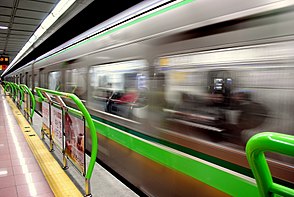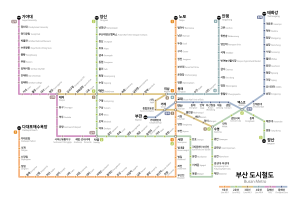Busan Subway
 |
|||

Train on Busan Metro Line 2
|
|||
| Overview | |||
|---|---|---|---|
| Native name | 부산 도시철도 釜山 都市鐵道 Busan dosicheoldo |
||
| Owner | City of Busan | ||
| Locale | Busan, South Korea | ||
| Transit type | Rapid transit, Commuter rail | ||
| Number of lines | 6 | ||
| Number of stations | 108 (metro only) 143 (incl. BGL, Donghae Line) |
||
| Daily ridership | 904,350(2016) | ||
| Operation | |||
| Began operation | 19 July 1985 | ||
| Operator(s) |
Busan Transportation Corporation B&G Metro Korail |
||
| Technical | |||
| System length | 108.5 km (67.4 mi) (metro only) 160.4 km (99.7 mi) (incl. BGL, Donghae Line) |
||
| Track gauge | 1,435 mm (4 ft 8 1⁄2 in) standard gauge | ||
|
|||
| Busan Metro | |
| Hangul | |
|---|---|
| Hanja | |
| Revised Romanization | Busan dosicheoldo |
| McCune–Reischauer | Pusan tosich'ŏlto |
The Busan Metro (Hangul: 부산 도시철도; Hanja: 釜山 都市鐵道; RR: Busan dosicheoldo) operated by the Busan Transportation Corporation is the urban rail system of Busan, South Korea. The metro network first opened in 1985 with seventeen stations. The Metro itself consists of 4 lines, cover 109.5 kilometres (68.0 mi) of route and serving 102 stations.
All directional signs on the Busan Metro are written in both Korean and English, and the voice announcement in the trains indicating the upcoming station, possible line transfer and exiting side are all spoken in Korean, followed by English. Announcements at stations for arriving trains are in Korean, followed by English, then Japanese and Mandarin. All stations are numbered and the first numeral of the number is the same as the line number, e.g. station 123 is on line 1.
The Metro map includes information on which station, and which numbered exit from that station, to use for main attractions. Photography in the Busan Metro is permitted.
...
Wikipedia


